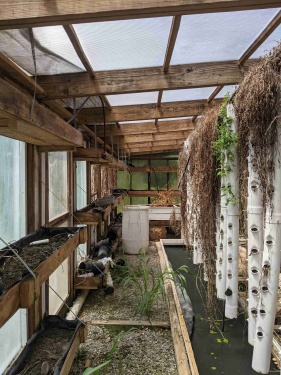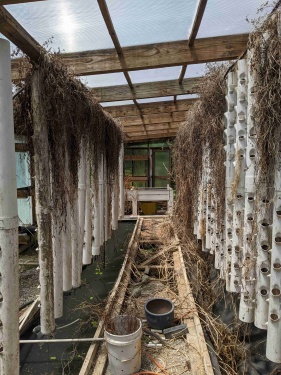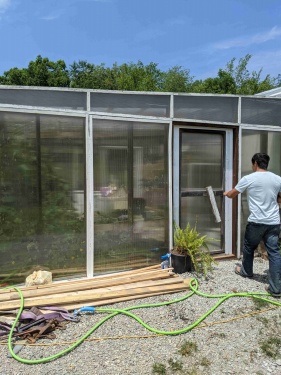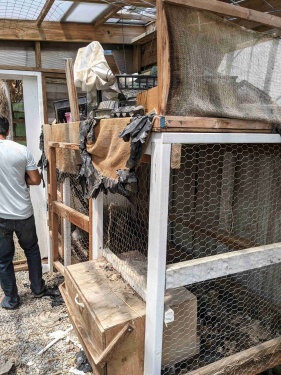Greenhouse Rehab
Greenhouse Rehabilitation 2021
[TODO: Insert before and after photos of 2016 greenhouse, and current state of greenhouse before we started cleaning it]
The aquaponics greenhouse and tilapia fish farm pools were created in 2015. They were a beautiful example of vertical farming and local, integrated food production of animal protein.
Since then, the greenhouse has experienced the following interesting failure modes, which are a case study for all other food production greenhouse projects.
Automated Watering System
High Level System Block Diagram
The key part that can be automated in the greenhouse is a watering system controlled by Arduino. This solves for human forgetfulness and will also let all community members easily monitor and control watering remotely, and after they have left Factor e Farm.
https://www.xythobuz.de/giessomat.html
We will be taking inspiration from this Arduino watering system on Hackadway with 3D printed parts, substituting out-of-stock parts or similar parts that we have on hand, for example, from the D3D printer.
Greenhouse Work Log
Revive a greenhouse in 15 minutes each day, for 120 days.
Failure Modes
- The water pump became clogged with fish waste, and stopped circulating water.
- The fish ponds froze over the winter, preserving the last remaining population of tilapia for consumption, but removing them as viable breeding stock for future populations.
Revival Plan
Wes and Paul have been clearing out items that are no longer useful in the greenhouse for composting or trash.
Aquaponics Greenhouse Revival Slides
- [IN PROGRESS] Remove all dead organic matter and compost it.
- Clean out chicken coop
- [DONE] Start avocado pits in water cups.
- [IN PROGRESS] Remove and catalogue all remaining pumps and powered watering equipment.
- [NEEDS EQUIPMENT] Transplant any remaining living plants into the raised bed, pots on the floor for taller plants.
- [IN PROGRESS] Test the existing tubing, both between the plant shelves and the solar heated section running along roof.
- Locate the 3D print files for threaded tube fittings and the seedling starter cones.
- Replant seedlings into labeled cones on the cone racks, so they can be fed into aquaponic towers and establish a root system in the sponge substrate.
- [NEEDS EQUIPMENT] Transplant the bamboo to an outdoor space where it can grow several meters tall and benefit from natural rainfall.
- [IN PROGRESS] Create a high-level system diagram of Arduino watering system, so we can order parts!
== Wild Edible Plants of Missouri
Wild Edible Plants of Missouri
If we can find these while foraging around Factor e Farm, or surrounding public lands, we can plant / transplant them into the greenhouse and attempt to cultivate them.
Compost and Soil Amendments
Although the aquaponic towers remove most of the need for traditional soil, seedlings must still be started in plastic coned-shaped tubes that are then inserted into the aquaponic towers. This requires soil, and benefits greatly from amendments such as nutrient-rich humus from finished compost, as well as perlite / sand to aerate the heavy Missouri clay that otherwise hardens and bakes, making it impossible for seedlings to establish roots.
Organic waste from the HabLab kitchen is being moved to a compost pile near the greenhouse, where it was decompose in full sunlight, be easily watered and turned every day, and be situated on bare ground to benefit from and attract earthworms, microbes, beneficial insects, and fungus.
Using the Berkeley method, each pile of compost can be finished in around 20 days and ready for reuse as organic fertilizer in the garden, perhaps mixed with other sources of fertilizer, in varying proportions
- store bought fertilizer
- plant food such as fermented soaked alfalfa from horse feed stores
This also prevents organic matter, rich in bacteria and nutrients, from going to waste, being burned as trash, or filling up landfills. By extension, once we have a system in place, we can gather compost from all other kitchens on Factor e Farm to contribute to the compost system, which is the source and primary input of plant nutrients into our greenhouse ecosystem.



